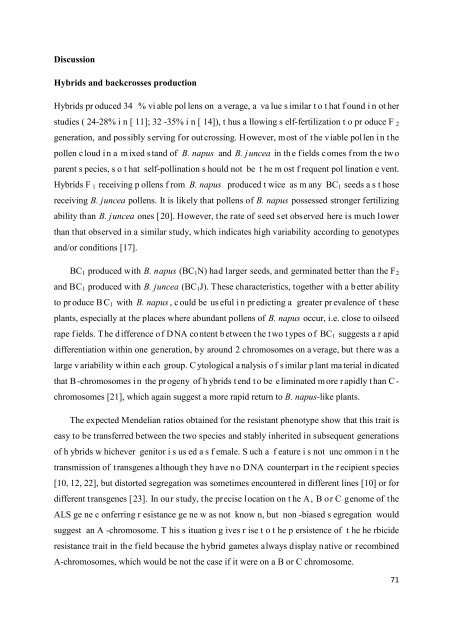UNIVERSITE DE BOURGOGNE THÈSE Yongbo LIU - Université de ...
UNIVERSITE DE BOURGOGNE THÈSE Yongbo LIU - Université de ...
UNIVERSITE DE BOURGOGNE THÈSE Yongbo LIU - Université de ...
Create successful ePaper yourself
Turn your PDF publications into a flip-book with our unique Google optimized e-Paper software.
Discussion<br />
Hybrids and backcrosses production<br />
Hybrids pr oduced 34 % vi able pol lens on a verage, a va lue s imilar t o t hat f ound i n ot her<br />
studies ( 24-28% i n [ 11]; 32 -35% i n [ 14]), t hus a llowing s elf-fertilization t o pr oduce F 2<br />
generation, and possibly serving for outcrossing. However, most of the viable pollen in the<br />
pollen c loud i n a m ixed s tand of B. napus and B. j uncea in th e fields comes from th e two<br />
parent s pecies, s o t hat self-pollination s hould not be t he m ost f requent pol lination e vent.<br />
Hybrids F 1 receiving p ollens f rom B. napus produced t wice as m any BC1 seeds a s t hose<br />
receiving B. juncea pollens. It is likely that pollens of B. napus possessed stronger fertilizing<br />
ability than B. juncea ones [20]. However, the rate of seed set observed here is much lower<br />
than that observed in a similar study, which indicates high variability according to genotypes<br />
and/or conditions [17].<br />
BC1 produced with B. napus (BC1N) had larger seeds, and germinated better than the F2<br />
and BC1 produced with B. juncea (BC1J). These characteristics, together with a b etter ability<br />
to pr oduce B C1 with B. napus , c ould be us eful i n pr edicting a greater pr evalence of t hese<br />
plants, especially at the places where abundant pollens of B. napus occur, i.e. close to oilseed<br />
rape fields. The d ifference o f DNA co ntent b etween t he t wo t ypes o f BC1 suggests a r apid<br />
differentiation within one generation, by around 2 chromosomes on a verage, but there was a<br />
large v ariability w ithin e ach group. C ytological a nalysis o f s imilar p lant ma terial in dicated<br />
that B-chromosomes i n the pr ogeny of h ybrids t end t o be e liminated m ore r apidly t han C -<br />
chromosomes [21], which again suggest a more rapid return to B. napus-like plants.<br />
The expected Men<strong>de</strong>lian ratios obtained for the resistant phenotype show that this trait is<br />
easy to be transferred between the two species and stably inherited in subsequent generations<br />
of h ybrids w hichever genitor i s us ed a s f emale. S uch a f eature i s not unc ommon i n t he<br />
transmission of transgenes although they h ave n o DNA counterpart in t he recipient species<br />
[10, 12, 22], but distorted segregation was sometimes encountered in different lines [10] or for<br />
different transgenes [23]. In our study, the precise location on t he A, B or C genome of the<br />
ALS ge ne c onferring r esistance ge ne w as not know n, but non -biased s egregation would<br />
suggest an A -chromosome. T his s ituation g ives r ise t o t he p ersistence of t he he rbici<strong>de</strong><br />
resistance trait in the field because the hybrid gametes always display native or recombined<br />
A-chromosomes, which would be not the case if it were on a B or C chromosome.<br />
71
















